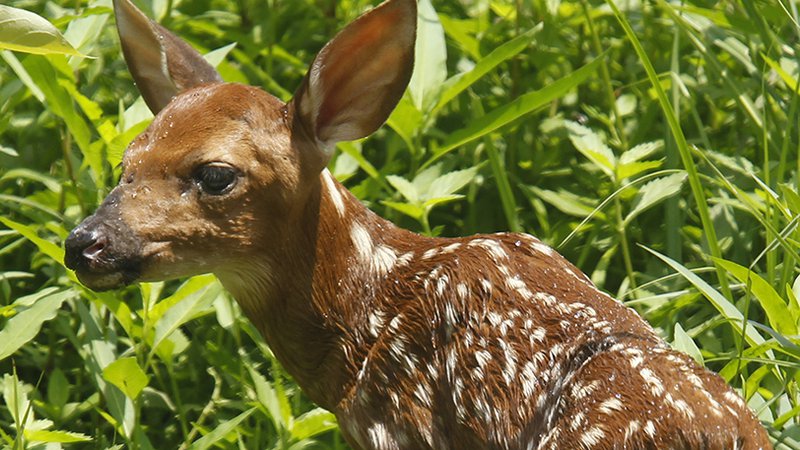Young deer, other wildlife likely not abandoned
ON 05-08-2019

May 8, 2019
Randy Zellers
Assistant Chief of Communications
LITTLE ROCK — Each spring hundreds of Arkansans likely stumble upon a small batch of rabbits, a helpless looking fawn or other young animals that’s been seemingly abandoned. The first temptation is to scoop these “defenseless” creatures up and try to find someone to care for them, but that may be the worst thing a person can do for that animal’s welfare.
Many animals, such as deer and rabbits, leave their young hidden in tall grass while they eat. The young animals carry much less scent than the adults, so they are harder for predators to find if the mother doesn’t spend all of her time in close proximity to them. The fawn or other young animals will stay as still as possible to try to remain hidden, using their spots or coloration as camouflage. Often, the mother is not too far away, waiting for people to leave before checking on her young. If a person takes that animal away, they may actually be causing an issue with those good intentions. This does not mean that the animal is sick, injured, or has been abandoned.
Not only does picking up baby wildlife create a bad situation for the young animal, in the case of deer, it also is illegal. Since the discovery of chronic wasting disease in Arkansas in 2016, biologists have taken every measure possible to slow its spread in the state. One potential way diseases can spread in wild populations is the movement of live animals by people. It is not entirely clear if CWD can spread from mother to young at birth, but positive cases of CWD have been identified in fawn and yearling deer. Because of this, all rehabilitation of deer and elk was eliminated in 2016 to prevent the disease from being inadvertently spread.
“You’re taking a deer with unknown history from one area to a rehabber in another area, then they may take it to yet a different area for release,” said A.J. Riggs, AGFC wildlife health biologist, during a recent presentation on CWD. “Those good intentions can lead to the rehabbers’ facilities becoming contaminated and being able to spread the disease.”
In addition to the risk of spreading disease, moving a fawn usually ends up being a bad situation for both the fawn and the well-meaning individuals. Research indicates that very few rehabilitated deer survive longer than a few months after release. Deer that have lost their fear of humans also can become aggressive and cause injuries to well-meaning individuals. Even though they may appear docile, deer can cause a good bit of harm with sharp hooves and powerful kicks.
If you feel that a fawn or other young animal is in immediate danger by laying in or very near a road or in the path of haying equipment, pick it up and move it over a few feet. Never remove it from the immediate area. The mother will periodically check on her young. She will not be deterred by “human scent,” that’s just an old wives’ tale. And if something has happened to the mother, most young animals are able to eat and digest native vegetation within a few weeks of birth. Fawns are completely weaned within two to three months.
A network of animal rehabilitators is available in Arkansas, and contact information can be found at www.agfc.com/rehab. These wildlife rehabilitators operate independently from the Arkansas Game and Fish Commission and are not funded by the AGFC. They do not charge for their services but may accept donations. Because of the high demand for rehabilitators, it is best to call ahead before ever thinking of moving an animal, even one that you know for a fact has lost its mother.
Recent News
Subscribe to Our Weekly Newsletter E-mails
Don’t miss another issue. Sign up now to receive the AGFC Wildlife Weekly Newsletter in your mailbox every Wednesday afternoon (Waterfowl Reports are published weekly during waterfowl season and periodically outside the season). Fishing Reports arrive on Thursdays. Fill in the following fields and hit submit. Thanks, and welcome!


